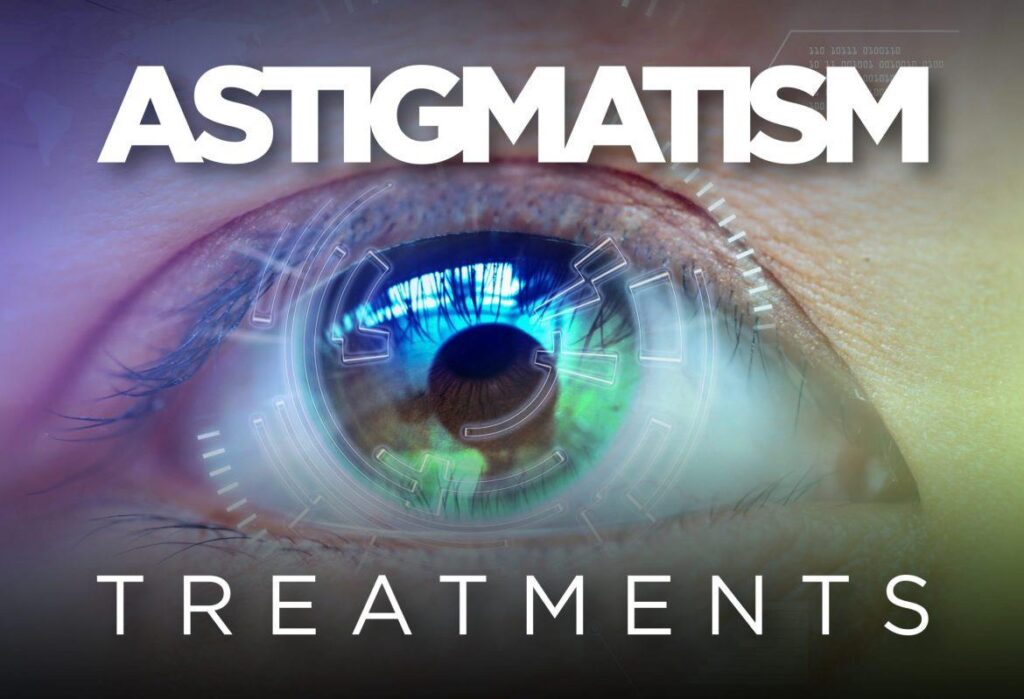ASTIGMATISM
Astigmatism Treatments: Understand Your Options
Astigmatism affects one out of every three people.
While it’s far from life-threatening, astigmatism does not go away. However, there are treatment options available to correct the condition, one of them being surgery. But is surgery is your only option? Let’s explore this.

What is astigmatism?
Astigmatism is a refractive error that impacts the way the eye focuses on light. It mainly affects those with either near or farsightedness and occurs when the cornea, the front cover of the eye, is shaped irregularly. It can also occur when the lens of the eye is irregularly curved.
In Can LASIK Fix Astigmatism?, Vance Thompson, M.D. puts it simply in layman’s terms by writing, “The cornea is shaped like an American football rather than like a baseball. Another [analogy] is to say that an eye with astigmatism is shaped like an egg or the back of a spoon, rather than like a ping-pong ball.”
Because of this irregularity, people with astigmatism often experience blurry vision, especially at far distances. This can then lead to headaches and eye strain. Additional symptoms include:
- Distorted vision
- Poor night vision
- Excessive squinting
- Irritation
The exact cause of astigmatism has yet to be discovered, but genetics and environmental factors are believed to be significant contributors to the condition. Many are born with astigmatism, which is known as congenital astigmatism. Those who have family members with astigmatism are predisposed to have the eye condition as well as those where additional eye disorders like keratoconus, a degeneration of the cornea, are present.
Keratitis, inflammation of the cornea, cysts, and glaucoma can also cause astigmatism, as can eyelid pressure. As you age, the pressure your eyelid applies to the cornea gets weaker, which can then have an impact on your vision.
Environmental factors that can contribute to astigmatism include:
- Nutrition
- Thinning or scarring of the cornea
- Cataract or retinal detachment surgery
- Trauma or injury
- Infection
Diagnosis and astigmatism treatments
Symptoms associated with astigmatism tend to develop slowly, so if you notice changes in your vision, schedule an appointment with your ophthalmologist or optometrist. They will administer a full eye exam, which may include the following:
- Refraction – A refraction test uses lenses of varying strengths to measure the power at which your eye can focus. While looking through the lens, your eye doctor will use a retinoscope, a tool that shines light onto the eye, and ask you to read a chart. This determines what strength eyeglass lenses you may need.
- Visual acuity – A visual acuity test determines how well you see the letters on an eye chart. Visual acuity is the number you receive, for instance, 20/20 is normal vision.
- Keratometry – Using a tool called a keratometer, your eye doctor will measure the curvature of your cornea. This is important for obtaining the exact measurement when fitting contact lens.
- Topography – A corneal topographer goes one step further than the keratometer and creates a map of the cornea’s contours. This provides an even more accurate rendering of the shape of your cornea.
If you are diagnosed with astigmatism, you may have several treatment options available to you.
Age-Related Macular Degeneration Symptoms
The following are the most common symptoms of age-related macular degeneration. However, each individual may experience symptoms differently. Symptoms may include:
- Blurry or fuzzy vision
- Difficulty recognizing familiar faces
- Straight lines appear wavy
- A dark, empty area or blind spot appears in the center of vision
- Loss of central vision, which is necessary for driving, reading, recognizing faces and performing close-up work
The presence of drusen, which are tiny yellow deposits in the retina, is one of the most common early signs of age-related macular degeneration. It may mean the eye is at risk for developing more severe age-related macular degeneration. These will be visible to your doctor during an eye exam.
The symptoms of age-related macular degeneration may look like other eye conditions. Speak with an eye care professional for diagnosis.
Age-Related Macular Degeneration Symptoms
In addition to a complete medical history and eye exam, your eye doctor may do the following tests to diagnose age-related macular degeneration:
- Visual acuity test. This common eye chart test measures vision ability at various distances.
- Pupil dilation. The pupil is widened with eyedrops to allow a close-up examination of the eye’s retina.
- Fluorescein angiography. Used to detect wet age-related macular degeneration, this diagnostic test involves a special dye injected into a vein in the arm. Pictures are then taken as the dye passes through the blood vessels in the retina, helping the doctor evaluate if the blood vessels are leaking and whether or not the leaking can be treated.
- Amsler grid. Used to detect wet age-related macular degeneration, this test uses a checkerboard like grid to determine if the straight lines in the pattern appear wavy or missing to the patient. Both indications may signal the possibility of age-related macular degeneration.
Eyeglasses
The most common treatment option is an eyeglasses prescription. Eyeglasses are the most non-invasive way to correct your vision. If you have astigmatism, you will be prescribed lenses with a cylindrical shape to offset the condition, as different parts of the lenses yield different degrees of strength.
Contact lenses
Similar to eyeglasses, contact lenses are a minimally invasive remedy for astigmatism. In fact, some people fare better wearing contacts over eyeglasses because they offer a wider field of vision.
The only downside is that corrective contacts for astigmatism often require rigid contacts over soft ones. Rigid gas permeable (RGP) or gas permeable (GP) contact lenses have their own benefits, making them even more ideal than soft contact lenses, however, they do take some getting used to.
RGP lenses contain silicone, which allows oxygen to pass through its surface with ease to keep the cornea healthy and lubricated without having to solely rely on tears. This feature allows them to filter more oxygen than even soft contact lenses. Because of this, RGP lenses can also be fitted closer to the eye’s surface and they are often fitted to cover more surface area—up to 75 percent of the cornea. All of these features combined allow for better vision in those with astigmatism.
Orthokeratology
Orthokeratology is the eye equivalent to wearing your retainer at night. This treatment option involves wearing rigid contact lenses for a window of time, at night, for instance. By doing so, you may then be able to go about your daily life with clearer vision. While this is not a permanent solution to correcting your vision, orthokeratology might be the ideal option for those with mild astigmatism.
PRK
Photorefractive keratectomy (PRK), also known as surface ablation, is a type of eye surgery performed to correct astigmatism. With this type of procedure, tissue is removed from the surface of the eye to change the shape of the cornea.
LASIK
Even more popular than PRK, LASIK surgery can also repair astigmatism. The lasers used to correct a person’s vision are so precise, they can work to reshape the cornea, correcting astigmatism as a result.

